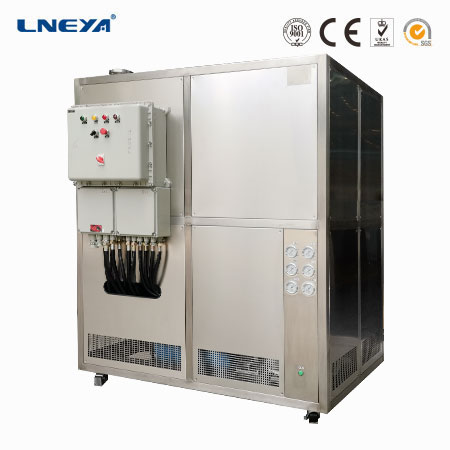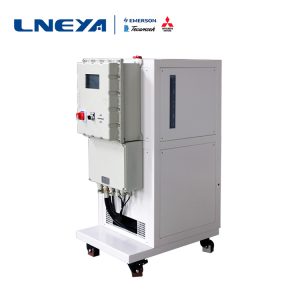Heat transfer oil chemical temperature control system product application
The heat transfer oil heating and cooling temperature control system is a device with heating or lowering at the same time, that is, when the temperature of the equipped glass reactor, rotary evaporator, extraction equipment and other devices needs to be raised or lowered rapidly to reach the set temperature. The heating and cooling of the equipment can be changed quickly, and the medium (heat-conducting oil) used is the same medium, which improves the disadvantage that two different instruments are needed for heating and cooling in the past. Not only improves production efficiency, but also more convenient to use.

The temperature requirements for the reaction of different materials are different:
There are many kinds of chemical products, and the temperature requirements for different materials to react are different. Some reactions can only be carried out until the endothermic temperature reaches a certain temperature, while some reactions can release a large amount of heat energy, which requires the heat transfer oil heating and cooling temperature control system to be able to Dynamically respond and implement heating and cooling control within the reactor.
To ensure accurate and stable temperature control:
In order to ensure the accuracy and stability of temperature control, the chemical production process also requires the temperature control equipment to have a high and low temperature integrated heat transfer oil heating and cooling temperature control system to respond quickly to temperature control, to have high temperature switching efficiency, and to quickly achieve the set target temperature. Meet the temperature requirements of the reactor in the reactor.
Application of heat transfer oil heating and cooling temperature control system:
The heat transfer oil heating and cooling temperature control system refers to a device specially designed for multi-point temperature control by the same unit. It is also very suitable for the site where the on-site working space is required.
The difference from ordinary heat transfer oil heating and cooling temperature control system:
The heat-conducting oil heating and cooling temperature control system equipment can control the temperature independently and can bring two hosts, (the ordinary heat-conducting oil heating and cooling temperature control system cannot be realized). Although the dual-machine integrated equipment is composed of two independent systems, it can be driven only by connecting a power cord (ordinary heat-conducting oil heating and cooling temperature control systems want to achieve dual-channel independent temperature control, two heat-conducting oil heating and cooling temperature control systems must be used , Need to connect two main power lines, the installation also takes a little more work and the price is much higher than the dual machine).
Resuma
In general, the chemical heat transfer oil heating and cooling temperature control system needs to have a large temperature control range, both heating and cooling. Accurate temperature control, high heating and cooling efficiency, fast operation response, etc.
Recomendaciones relacionadas
-
Termostato del reactor Equipo de calefacción y circulación
1283Reactor thermostat heating circulation equipment is a kind of equipment used to accurately control the temperature in the reactor during the chemical reaction process to ensure that the chemical reaction can be carried out under the set te...
Ver detalles -
-
Basic maintenance of high and low temperature refrigeration circulating pumps
2162Properly perform the sequence of opening and closing of the high and low temperature refrigeration cycle pump group to ensure normal operation after the host is started. Note that the condenser heats up well, otherwise the high temperature protect...
Ver detalles -
High and low temperature alternating wet heat shock test box function description
1552Consumers need to pay attention to the performance of the high and low temperature alternating wet heat shock test chamber. LNEYA's test chamber is closer to the needs of the purchasing company. The high and low temperature alternating heat and hu...
Ver detalles
 LNEYA Enfriadoras industriales Fabricante Proveedor
LNEYA Enfriadoras industriales Fabricante Proveedor












